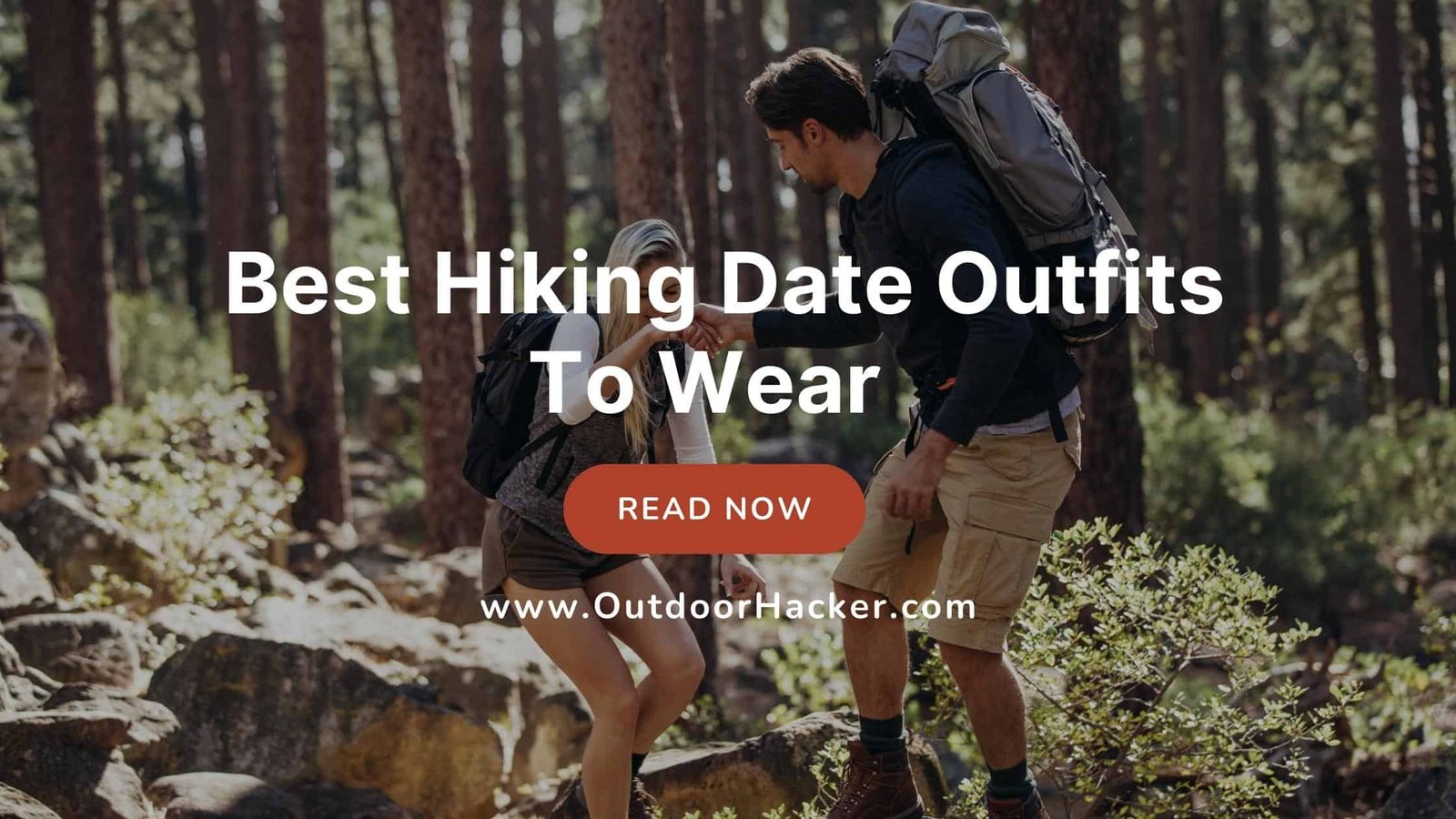Picture this: You’re standing at the trailhead, the crisp mountain air filling your lungs, and the promise of adventure stretching out before you. But in this age of technology, your most powerful hiking companion might just be sitting in your pocket. Welcome to our comprehensive guide to the best hiking apps of 2024, where we’ll equip you with the digital tools to transform your outdoor experiences.
Why do you need these apps?
Well, consider this: According to the Outdoor Industry Association, hiking participation in the U.S. has increased by a staggering 57.8% since 2020, with over 57.8 million Americans hitting the trails in 2022 alone. As more people embrace the great outdoors, the need for reliable, feature-rich hiking apps has never been greater.
From precise GPS navigation that keeps you on track to augmented reality features that unveil the mysteries of mountain peaks and night skies, these apps enhance every aspect of your hiking experience.
So, lace up your boots, grab your smartphone, and join us as we explore the digital tools that are revolutionizing the way we experience the great outdoors. Your next unforgettable adventure is just a download away!
Table Of Contents
- 1 Best Hiking Apps: A Perfect Companion For Your Hikes
- 1.1 1. AllTrails: Your All-in-One Hiking Companion
- 1.2 2. PeakVisor: Augmented Reality Mountain Identification
- 1.3 3. Gaia GPS: The Hiker’s Navigation Powerhouse
- 1.4 4. Hiking Project: Community-Driven Trail Information
- 1.5 5. PeakFinder AR: Elevate Your Mountain Knowledge
- 1.6 6. Cairn: Safety First for Solo Hikers
- 1.7 7. ViewRanger / Outdooractive : A Versatile Option for Global Trekkers
- 1.8 8. Komoot: Plan, Navigate, and Share Your Adventures
- 1.9 9. Star Walk 2: Stargazing on the Trail
- 1.10 10. Seek by iNaturalist
- 2 Tips to Maximize Your Hiking App Experience
- 2.1 1. Master the Offline Mode
- 2.2 2. Customize Your Map Display
- 2.3 3. Leverage Community Features
- 2.4 4. Integrate with Other Devices
- 2.5 5. Utilize Route Planning Tools
- 2.6 6. Optimize Battery Usage
- 2.7 7. Explore Educational Features
- 2.8 8. Utilize Safety Features
- 2.9 9. Combine Multiple Apps
- 2.10 10. Regular App Maintenance
- 2.11 11. Practice Responsible Digital Hiking
- 3 Conclusion: Choosing the Best Hiking App for Your Adventures
Best Hiking Apps: A Perfect Companion For Your Hikes
1. AllTrails: Your All-in-One Hiking Companion
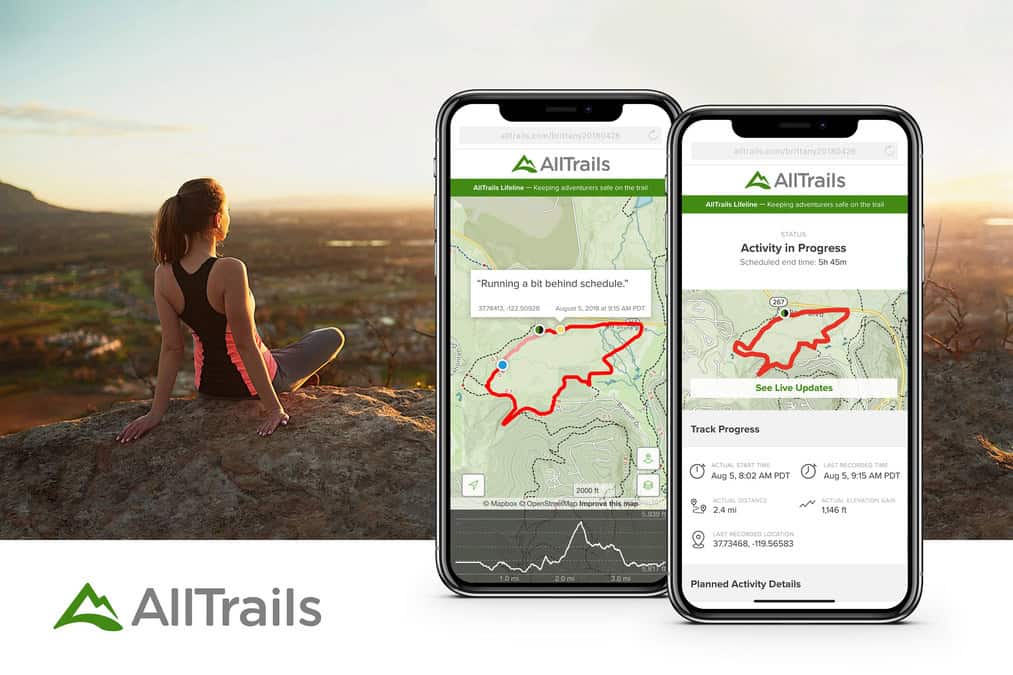
AllTrails continues to reign supreme in the hiking app ecosystem, and for good reason. This versatile application boasts an extensive database of over 300,000 trails worldwide, making it an invaluable resource for hikers of all levels.
Pros:
- Comprehensive trail database with user-generated content
- Detailed trail information including difficulty, elevation, and user reviews
- Offline maps available for premium users
- GPS tracking and real-time location sharing for safety
Cons:
- Some advanced features require a paid subscription
- Occasional inaccuracies in user-submitted trail data
Quick Specs:
- Free version available with basic features
- Premium version: $29.99/year
- Compatibility: iOS and Android
- Offline functionality: Yes (Premium)
Download on iPhone or Android.
2. PeakVisor: Augmented Reality Mountain Identification
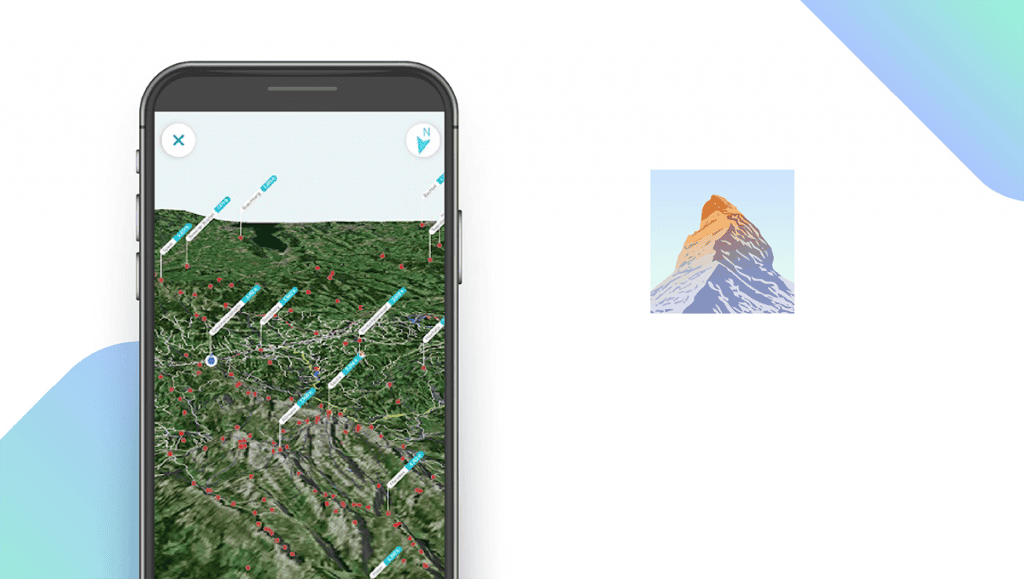
PeakVisor is a groundbreaking app that combines augmented reality with mountain identification, making it an essential tool for hikers and mountaineers who want to explore and learn about their surroundings.
Pros:
- Real-time mountain identification using your device’s camera
- 3D maps and panoramas of mountain ranges worldwide
- Offline functionality for use in remote areas
- Detailed information on peaks, including elevation and prominence
Cons:
- May drain battery quickly when using AR features extensively
- Some users report occasional inaccuracies in peak identification
Quick Specs:
- Basic version: Free
- Premium version: $29.99/year
- Compatibility: iOS and Android
- Offline functionality: Yes
Download on iPhone or Android.
3. Gaia GPS: The Hiker’s Navigation Powerhouse
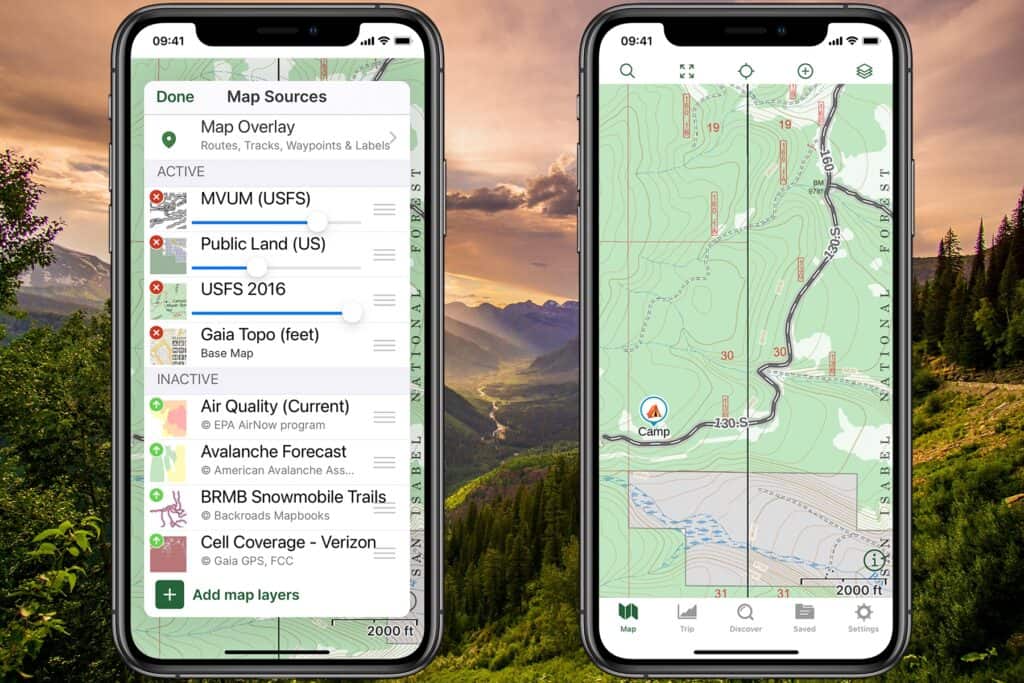
For those seeking professional-grade navigation tools, Gaia GPS stands out as a top contender. This robust app caters to serious hikers and backpackers who demand precision and reliability in their outdoor navigation.
Pros:
- High-quality topographic maps and satellite imagery
- Advanced route planning and tracking features
- Excellent offline capabilities
- Integration with a wide range of GPS devices
Cons:
- Steeper learning curve for beginners
- Premium features come at a higher price point
Quick Specs:
- Basic version: Free
- Premium version: $39.99/year
- Compatibility: iOS and Android
- Offline functionality: Yes
Download on iPhone or Android.
4. Hiking Project: Community-Driven Trail Information
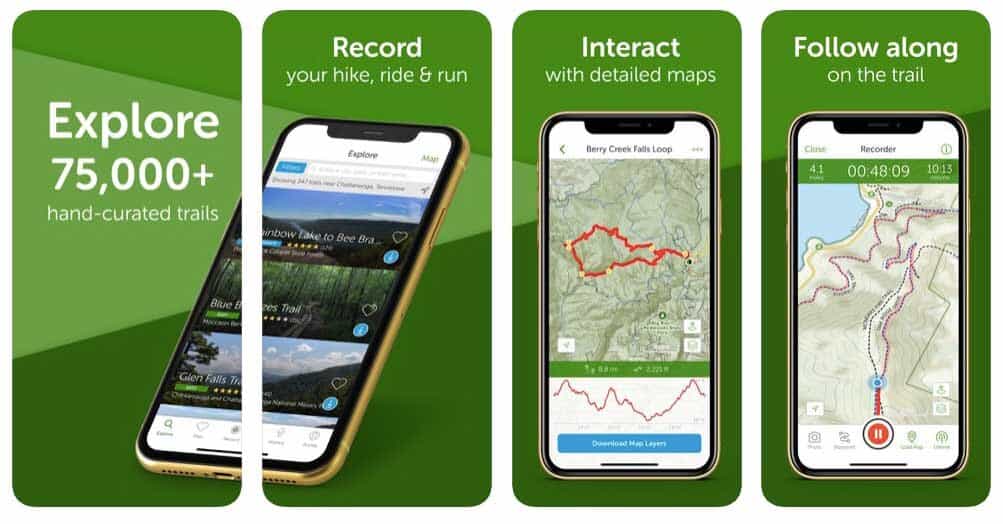
The Hiking Project app, developed by REI Co-op, harnesses the power of community to provide a wealth of trail information. This free app is an excellent resource for hikers looking for detailed, crowd-sourced trail data.
Pros:
- Completely free with no in-app purchases
- High-quality trail guides with photos and descriptions
- Offline maps available for download
- Regular updates from a passionate hiking community
Cons:
- Limited coverage in some remote areas
- Less robust navigation features compared to paid apps
Quick Specs:
- Cost: Free
- Compatibility: iOS and Android
- Offline functionality: Yes
Download on iPhone or Android.
5. PeakFinder AR: Elevate Your Mountain Knowledge
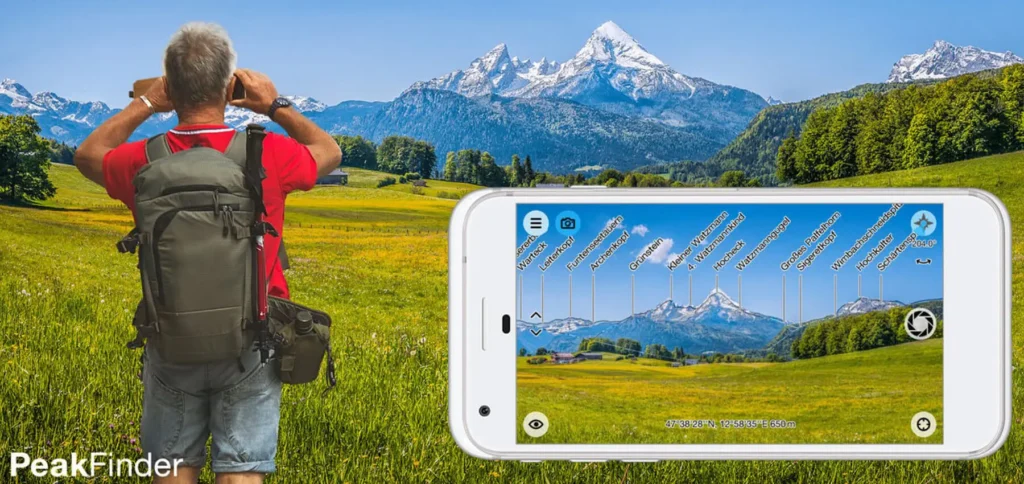
While not strictly a hiking app, PeakFinder AR deserves a spot on this list for its unique augmented reality feature that enhances any mountain hiking experience. This app allows you to identify peaks and landmarks in real-time using your device’s camera.
Pros:
- Augmented reality view of mountain ranges and peaks
- Works offline with a global mountain database
- Educational tool for learning about geographical features
- Panorama creator and sharing capabilities
Cons:
- Limited usefulness for non-mountain terrain
- One-time purchase cost may be high for casual users
Quick Specs:
- Cost: $4.99 (one-time purchase)
- Compatibility: iOS and Android
- Offline functionality: Yes
Download on iPhone or Android.
6. Cairn: Safety First for Solo Hikers
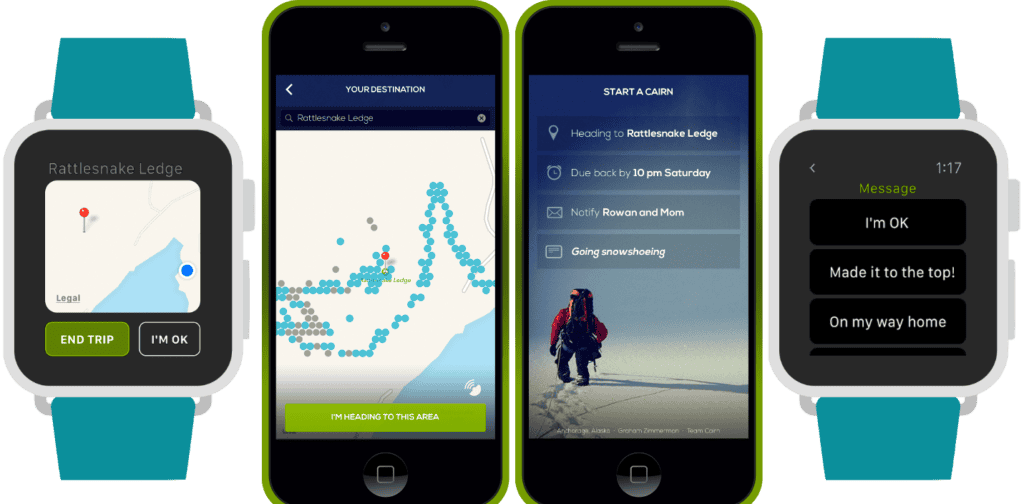
Cairn focuses on hiker safety, making it an essential app for those who often venture out alone or in remote areas. Its unique features are designed to keep you safe and connected, even in areas with limited cell coverage.
Pros:
- Real-time location sharing with designated contacts
- Crowdsourced cell phone coverage maps
- Automatic alerts if you don’t return on time
- Emergency contact information even without cell service
Cons:
- Some features require a subscription
- Battery drain can be significant with constant tracking
Quick Specs:
- Basic version: Free
- Premium version: $26.99/year
- Compatibility: iOS and Android
- Offline functionality: Partial
Download on iPhone or Android.
7. ViewRanger / Outdooractive : A Versatile Option for Global Trekkers
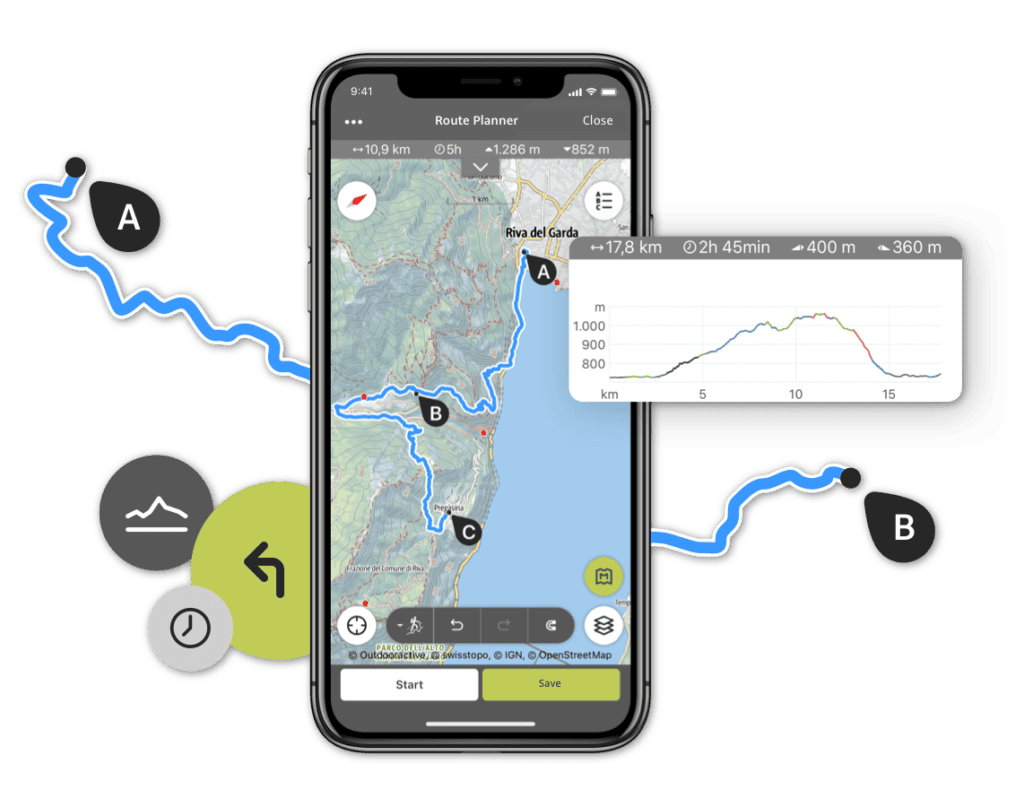
ViewRanger or Outdooractive offers a comprehensive suite of features for hikers, including access to a vast library of routes across the globe. Its augmented reality feature, similar to PeakFinder, adds an extra dimension to your hiking experience.
Pros:
- Extensive collection of downloadable route guides
- Augmented reality skyline identification
- Compatibility with various wearable devices
- Robust offline mapping capabilities
Cons:
- Interface can be cluttered and overwhelming for new users
- Premium maps and features require additional purchases
Quick Specs:
- Basic version: Free
- Premium features: Vary by map and region
- Compatibility: iOS and Android
- Offline functionality: Yes
Download on iPhone or Android.
8. Komoot: Plan, Navigate, and Share Your Adventures
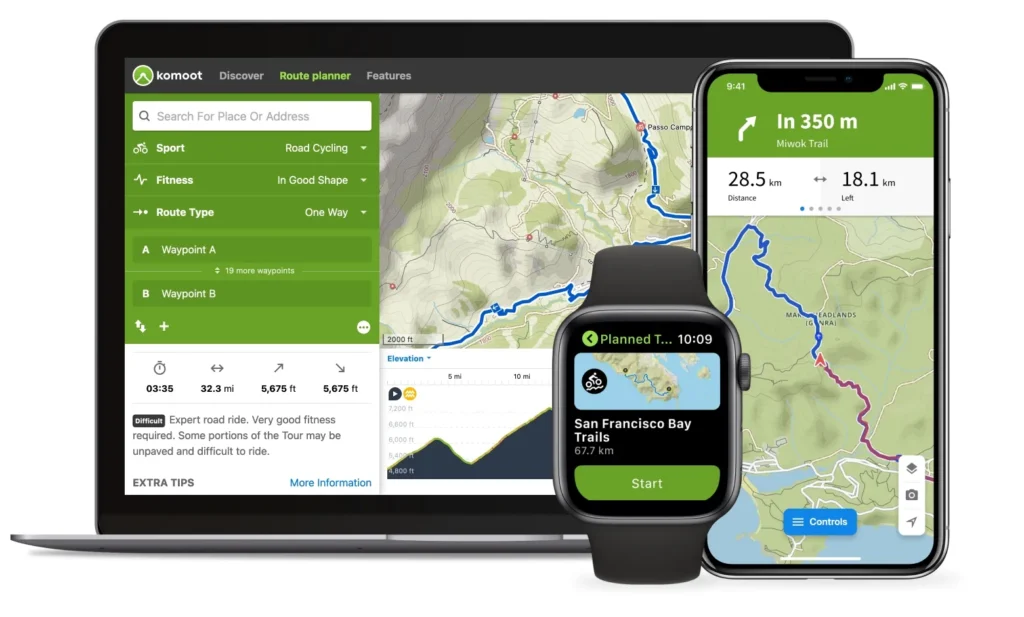
Komoot excels in route planning and navigation, offering turn-by-turn voice guidance for hikers. Its community features also make it easy to discover new trails and share your own experiences.
Pros:
- Intelligent route planning based on your fitness level and preferences
- Voice navigation for hands-free guidance
- Easy-to-use interface for creating and sharing routes
- Integration with various fitness devices and platforms
Cons:
- Some regions require separate map purchases
- Community content may be limited in less popular areas
Quick Specs:
- Basic version: Free
- World Pack (all regions): $29.99 (one-time purchase)
- Compatibility: iOS and Android
- Offline functionality: Yes (with purchased maps)
Download on iPhone or Android.
9. Star Walk 2: Stargazing on the Trail
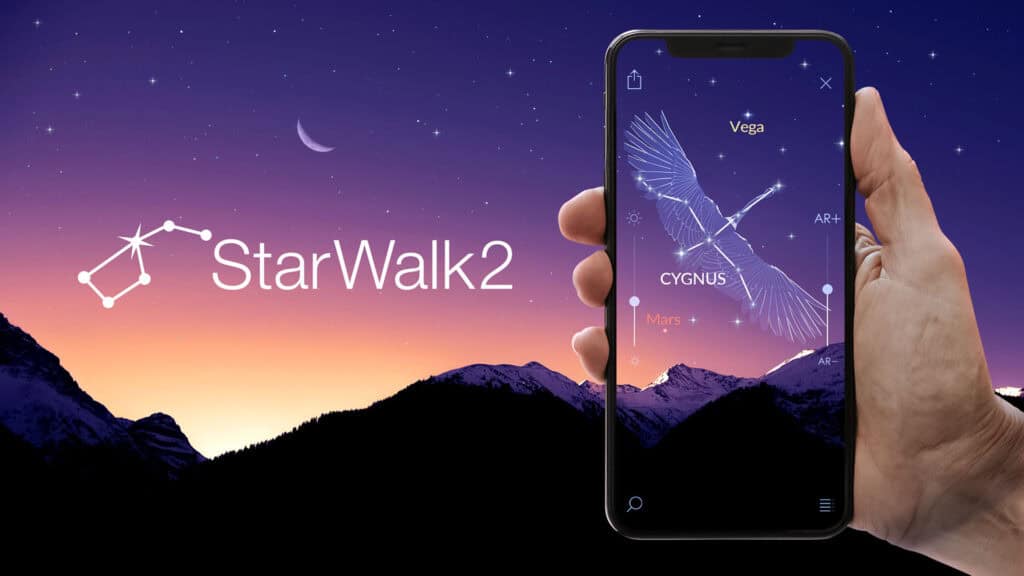
While not strictly a hiking app, Star Walk 2 is an excellent companion for night hikers and campers who want to explore the night sky during their outdoor adventures.
Pros:
- Augmented reality star and constellation identification
- Detailed information on celestial objects
- Time machine feature to view the sky at different dates and times
- Beautiful, user-friendly interface
Cons:
- Not specifically designed for hiking, lacks trail information
- Some features require in-app purchases
Quick Specs:
- Basic version: $2.99 (one-time purchase)
- Additional content available through in-app purchases
- Compatibility: iOS and Android
- Offline functionality: Partial
Download on iPhone or Android.
10. Seek by iNaturalist
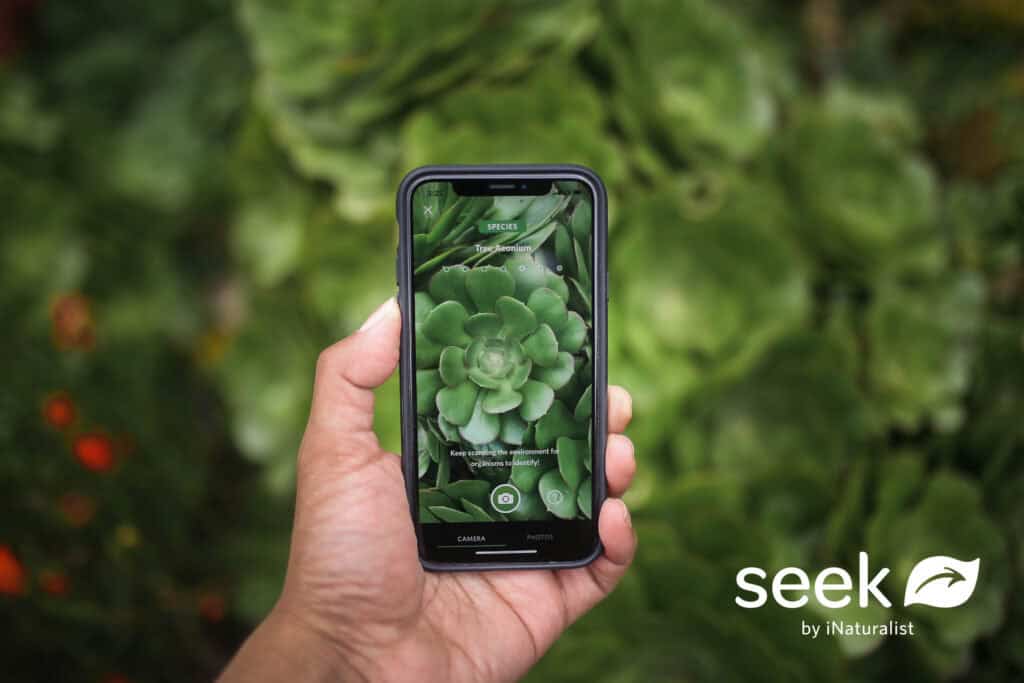
Seek by iNaturalist is a fantastic app for hikers interested in identifying plants, animals, and fungi encountered on the trail. It’s like having a naturalist in your pocket.
Pros:
- Instant species identification using your device’s camera
- Educational content about local ecosystems
- Gamification elements to encourage exploration and learning
- No account required, ensuring privacy
Cons:
- Requires an internet connection for best performance
- May not identify all species in very remote or understudied areas
Quick Specs:
- Cost: Free
- Compatibility: iOS and Android
- Offline functionality: Limited
Download on iPhone or Android.
Tips to Maximize Your Hiking App Experience
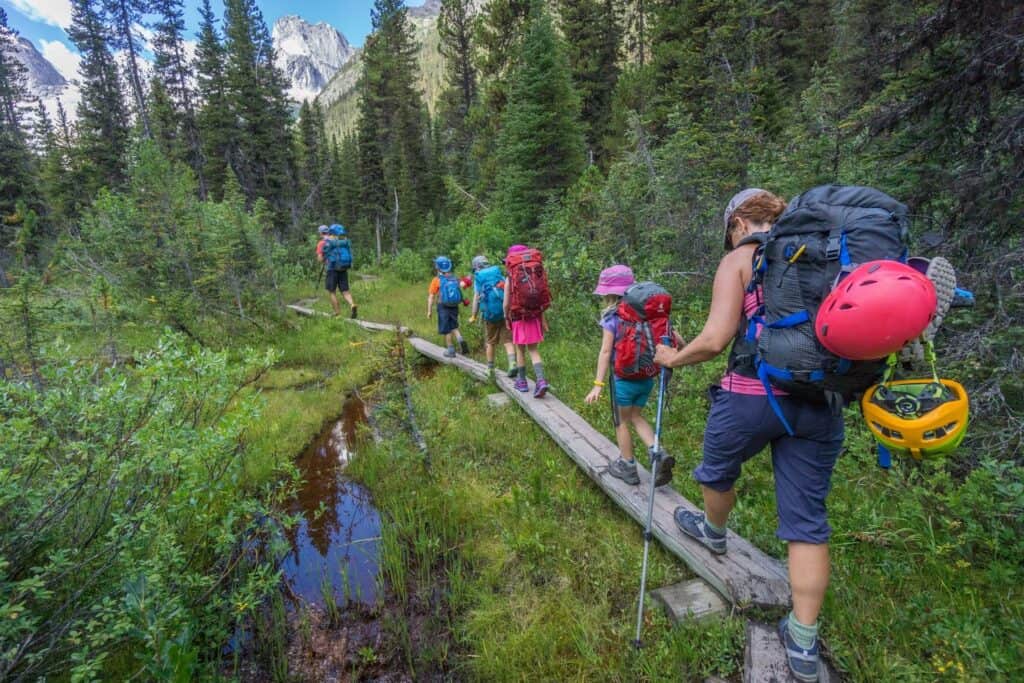
Hiking apps have revolutionized the way we explore the great outdoors, offering a wealth of information and features at our fingertips.
To help you make the most of these powerful tools, we’ve compiled a list of expert tips that will elevate your hiking experience and ensure you’re using your app to its fullest potential.
1. Master the Offline Mode
Offline functionality is crucial when venturing into areas with poor cell coverage. To make the most of this feature:
- Download maps and trail data before leaving home
- Test the offline mode in a safe environment to ensure you understand its limitations
- Regularly update your offline content to ensure you have the latest information
By mastering offline mode, you’ll never be left stranded without crucial navigation tools.
2. Customize Your Map Display
Most hiking apps offer various map layers and display options. Take time to:
- Experiment with different map types (topographic, satellite, etc.) to find what works best for you
- Adjust map overlays to show or hide specific information like contour lines or points of interest
- Save custom map settings for quick access during your hikes
A well-customized map can significantly improve your navigation and trail understanding.
3. Leverage Community Features
Many hiking apps have robust community sections. Make the most of these by:
- Reading recent trail reviews before your hike for up-to-date conditions
- Contributing your own reviews and photos to help fellow hikers
- Joining app-specific hiking groups for tips and meetups
Engaging with the community can provide valuable insights and enhance your overall hiking experience.
4. Integrate with Other Devices
To expand your app’s capabilities:
- Sync your app with GPS watches or fitness trackers for more accurate data
- Use Bluetooth heart rate monitors for detailed health metrics during your hike
- Connect to external GPS receivers for improved accuracy in challenging terrain
Integration with other devices can provide a more comprehensive overview of your hiking performance and surroundings.
5. Utilize Route Planning Tools
Many apps offer advanced route planning features. To use these effectively:
- Create custom routes by connecting existing trails or plotting your own path
- Use elevation profiles to gauge the difficulty of your planned hike
- Share your planned route with friends or family for safety
Proper route planning can help you tackle more ambitious hikes with confidence.
6. Optimize Battery Usage
To ensure your app remains functional throughout long hikes:
- Use airplane mode when not actively needing cellular data
- Lower screen brightness and disable unnecessary notifications
- Invest in a high-capacity portable charger for multi-day trips
- Consider a solar charger for extended backcountry adventures
With these strategies, you can significantly extend your device’s battery life on the trail.
7. Explore Educational Features
Many hiking apps offer educational content. Take advantage of this by:
- Using built-in flora and fauna identification tools to learn about local ecosystems
- Exploring geological information about the areas you’re hiking
- Learning about local history through app-provided information on historical sites and landmarks
These features can transform your hike into an immersive learning experience.
8. Utilize Safety Features
Safety should always be a top priority. Make the most of your app’s safety features by:
- Setting up emergency contacts within the app
- Using location sharing features to keep loved ones informed of your progress
- Familiarizing yourself with the SOS function before you need it
- Regularly checking in using the app’s safety check feature if available
Proper use of these features can provide peace of mind and quick assistance if needed.
9. Combine Multiple Apps
Don’t be afraid to use multiple apps for different purposes:
- Use a dedicated navigation app like Gaia GPS for detailed mapping
- Complement with a wildlife identification app like Seek by iNaturalist
- Add a weather app for real-time forecasts specific to your hiking area
By combining specialized apps, you create a comprehensive digital toolkit for your adventures.
10. Regular App Maintenance
- Keep your app updated to access the latest features and bug fixes
- Regularly clear cached data to free up storage space
- Backup your hiking data to prevent loss of important information
- Periodically review and update your settings to match your evolving needs
Regular maintenance ensures your app remains a reliable tool for all your hiking adventures.
11. Practice Responsible Digital Hiking
While hiking apps are incredibly useful, it’s important to use them responsibly:
- Don’t rely solely on your app – always carry a physical map and compass as backup
- Be present in nature – avoid constant app checking and enjoy your surroundings
- Respect trail regulations – some areas may have restrictions on GPS or camera use
- Practice Leave No Trace principles – including being mindful of sharing sensitive locations online
By following these tips, you’ll not only enhance your own hiking experience but also contribute positively to the hiking community and the preservation of natural spaces.
Conclusion: Choosing the Best Hiking App for Your Adventures
As we’ve explored the best hiking apps of 2024, it’s clear that there’s no one-size-fits-all solution. Each app offers unique features that cater to different hiking styles and preferences.
We recommend trying out several apps to find the one that best suits your needs. Many offer free versions or trials, allowing you to test their functionality before committing to a subscription. Remember to always carry a physical map and compass as backup, and never rely solely on digital tools when venturing into the wilderness.
Happy trails, and may your future hikes be filled with adventure, discovery, and the confidence that comes from having the right tools at your fingertips!











